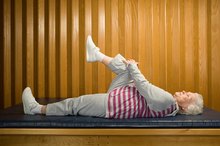Disabled People Diet & Exercise
**A disabled person is considered anyone who has a physical limitation that makes it difficult to work or perform activities of daily living.
** According to the American Association on Health and Disability, this can include sensory deprivation, such as blindness or deafness, spinal cord injury, traumatic brain injury, developmental limitations like cerebral palsy or mental retardation, stroke or other severe, adult on-set disease. To maintain health and wellness, diet and exercise should be included in treatment and prevention.
Problems
If you are disabled, you know it can be tough to get around. **Being sedentary can cause many health-related problems.
** Being physically inactive puts you at risk for secondary health-related issues. According to the American Association on Health and Disability, some secondary health issues that a disabled person might be susceptible to are asthma, cancer, coronary artery disease, diabetes, depression, hypertension, obesity, transient ischemic attacks, stroke, chronic obstructive pulmonary disease, heart failure and seizures.
- If you are disabled, you know it can be tough to get around.
- Being sedentary can cause many health-related problems.
Exercise
Exercise for 66-Year-Olds
Learn More
Exercise is extremely important if you have a disability. For some, it can prevent the disability from becoming worse. For others, it can prevent a secondary disease from developing. For example, a study published in the journal "Multiple Sclerosis" in 2004 by Anders Romberg evaluated the correlation between exercise capacity and disability 1. The results showed that disability is directly related to exercise capacity, even with people who are ambulatory. Exercise should be used to improve cardiovascular health. Another study published in the "Journal of the American Medical Association" by Evette Weil and colleagues in 2002 studied the prevalence of obesity in people with a disability. The study found that obesity is prevalent in people with sensory, physical or mental disabilities and exercise should be used to combat it.
- Exercise is extremely important if you have a disability.
- Another study published in the "Journal of the American Medical Association" by Evette Weil and colleagues in 2002 studied the prevalence of obesity in people with a disability.
Exercise Program
A good exercise program should emphasize aerobic, resistive, balance and flexibility training. Aerobic exercise should be done most days of the week for a total of 30 minutes. If you are deconditioned, you may exercise for bouts of five to 10 minutes, totaling 30 minutes. Intensity should be as tolerated and increased as it feels easier. Muscular strength should emphasize working large, functional muscles. These include leg, back, arm and chest muscles. Exercise should be done two to three days per week with a day of rest between. Perform exercises for one to two sets of 10 to 15 repetitions. Flexibility can be done daily. It is used to maintain range of motion of working muscles and joints.
Perform at least four repetitions per muscle, emphasizing similar muscles that you work during resistance training.
Be sure to hold a stretch static for 15 to 30 seconds in a pain-free range. It should be noted that most exercises can be altered to fit someone in a wheelchair.
- A good exercise program should emphasize aerobic, resistive, balance and flexibility training.
- It should be noted that most exercises can be altered to fit someone in a wheelchair.
Nutrition
Exercise Precautions & Contraindications in Rheumatoid Arthritis
Learn More
Malnutrition can occur for several reasons. Shopping for and preparing foods can feel like a day's work if you are disabled and deconditioned. Special care should be given to maintaining proper nutrition. In a study published in the "Journal of Gerontology" in 2000 by Giovanni Zuliani and colleagues, nutrition in older disabled persons was analyzed.
This study found that malnutrition can be a predictor in worsening disability. Therefore, nutrition should be assessed and maintained.
- Malnutrition can occur for several reasons.
- This study found that malnutrition can be a predictor in worsening disability.
Nutrition Program
Healthy foods in the form of dairy, fruit, vegetables and whole grains should be at the top of your grocery list if you are disabled. A study published in the "American Journal of Clinical Nutrition" in 2005 by Denise Houston evaluated the effects of a healthy diet on disabilities. This study concluded that intakes of healthy foods, like dairy, fruits and vegetables, helped decrease functional limitations in people with a disability.
Related Articles
References
- Sage Journals Online: Exercise Capacity, Disability and Leisure Physical Activity of Subjects With Multiple Sclerosis
- "Health Fitness Instructor's Handbook"; Howley, Edward T., B. Don Franks; 2003
- Lee S, Mendelsohn A, Srnes E. The burden of psoriatic arthritis. A literature review from a global health systems perspective. P T. 2010 Dec; 35(12): 680–689
- Social Security Administration. Disability Evaluation Under Social Security. 14.00 Immune System Disorders – Adult.
- Beswick AD, Wylde V, Gooberman-Hill R, et al. What proportion of patients report long-term pain after total hip or knee replacement for osteoarthritis? A systematic review of prospective studies in unselected patients. BMJ Open 2012;2:e000435. doi:10.1136/bmjopen-2011-000435
- Ferket BS, Feldman Z, Zhou J, et al. Impact of total knee replacement practice: cost effectiveness analysis of data from the Osteoarthritis Initiative. BMJ 2017;356:j1131. doi:10.1136/bmj.j1131
- Haddad A, Chandran V. Arthritis mutilans. Curr Rheumatol Rep (2013) 15: 321. doi:10.1007/s11926-013-0321-7
- Dogra A, Arora AK. Nail psoriasis: The journey so far. Indian J Dermatol. 2014 Jul-Aug; 59(4): 319–333. doi:10.4103/0019-5154.135470
- Tillett W, Lin C., Zbrozek A. et al. A Threshold of Meaning for Work Disability Improvement in Psoriatic Arthritis Measured by the Work Productivity and Activity Impairment Questionnaire. Rheumatol Ther (2019) 6: 379. doi:10.1007/s40744-019-0155-5
- Mease P, Strand V, Gladman D. Functional impairment measurement in psoriatic arthritis: Importance and challenges. Semin Arthritis Rheum. 2018 Dec;48(3):436-448. doi:10.1016/j.semarthrit.2018.05.010
- Social Security Administration. Disability Evaluation Under Social Security. 1.00 Musculoskeletal System – Adult.
Writer Bio
Laura Niedziocha began her writing career in 2007. She has contributed material to the Stoneking Physical Therapy and Wellness Center in Lambertville, N.J., and her work has appeared in various online publications. Niedziocha graduated from Temple University with a Bachelor of Science in exercise science. She also has her Associate of Arts in communications from the Community College of Philadelphia.









